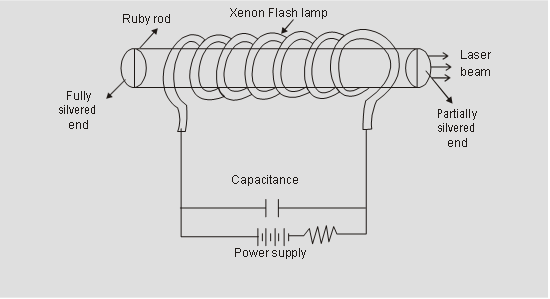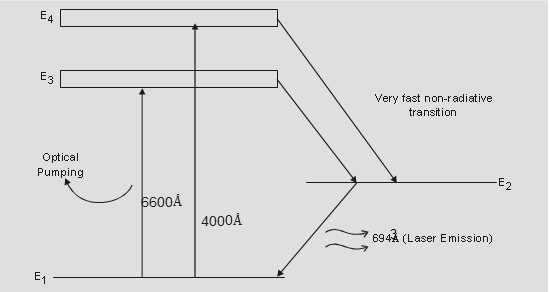Construction and working of Ruby laser
The following article will explain each and everything about Ruby laser that is everything about the construction and working of Ruby laser:
The first laser to be operated successfully was a ruby laser. The first demonstration of laser action using ruby crystal was given by T.H. Maiman in 1960. It is a solid-state laser.
Construction
Ruby is a crystal of aluminum oxide (Al2O3) in which some of the aluminum ions (Al3+) are replaced by chromium ions (Cr3+). This is done by doping small amounts of chromium oxide (Cr2O3) in the melt of purified Al2O3.
These chromium ions give the crystal a pink or red color depending upon the concentration of chromium ions. Laser rods are prepared from a single crystal of pink ruby which contains 0.05% (by weight) chromium. Al2O3 does not participate in the laser action. It only acts as the host.
The ruby crystal is in the form of a cylinder. The length of ruby crystal is usually 2 cm to 30 cm and diameter 0.5 cm to 2 cm. As a very high temperature is produced during the operation of the laser, the rod is surrounded by liquid nitrogen to cool the apparatus.
Active medium or active center: Chromium ions act as active centers in ruby crystals. So it is the chromium ions that produce the laser.
Pumping source: A helical flash lamp filled with xenon is used as a pumping source. The ruby crystal is placed inside a xenon flash lamp. Thus, optical pumping is used to achieve population inversion in ruby laser.
Optical resonator system: The ends of ruby crystal are polished, grounded, and made flat. One of the ends is completely silvered while the other one is partially silvered to get the output. Thus the two polished ends act as an optical resonator system.

Working
Let us now discuss the working of ruby laser.
Ruby is a three-level laser system. Suppose there are three levels E1, E2, and (E3 & E4). E1 is the ground level, E2 is the metastable level, E3 and E4 are the bands. E3 & E4 are considered as only one level because they are very closed to each other.
Pumping: The ruby crystal is placed inside a xenon flash lamp and the flash lamp is connected to a capacitor which discharges a few thousand joules of energy in a few milliseconds. A part of this energy is absorbed by chromium ions in the ground state. Thus optical pumping raises the chromium ions to energy levels inside the bands E3 and E4. This process is called stimulated absorption. The transition to bands E3 and E4 are caused by absorption of radiations corresponding to wavelengths approximately 6600 angstroms and 4000 angstroms respectively. The levels inside the bands E3 and E4 are also known as pumping levels.
Achievement of population inversion: Cr3+ ions in the excited state lose a part of their energy during interaction with crystal lattice and decay to the metastable state E2. Thus, the transition from excited states to metastable states is a non-radiative transition or in other words, there is no emission of photons. As E2 is a metastable state, chromium ions will stay there for a longer time. Hence, the number of chromium ions goes on increasing in the E2 state, while due to pumping, the number in the ground state E1 goes on decreasing. As a result, the number of chromium ions becomes more in an excited state(metastable state) as compared to ground state E1. Hence, the population inversion is achieved between states E2 and E1.

Achievement of laser: Few of the chromium ions will come back from E2 to E1 by the process of spontaneous emission by emitting photons. The wavelength of a photon is 6943 Å. This photon travels through the ruby rod and if it is moving in a direction parallel to the axis of the crystal, then it is reflected to and fro by the silvered ends of the ruby rod until it stimulates the other excited ions and causes it to emit a fresh photon in phase with the stimulating photon. Thus, the reflections will result in stimulated emission and it will result in the amplification of the stimulated emitting photons. This stimulated emission is the laser transition.
The two stimulated emitted photons will knock out more photons by stimulating the chromium ions and their total number will be four and so on. This process is repeated again and again, thus photons multiply. When the photon beam becomes sufficiently intense, then a very powerful and narrow beam of red light of wavelength 6943 Å emerges through the partially silvered end of the ruby crystal.
In the energy level diagram, E2 is the upper laser level and E1 is the lower laser level because the laser beam is achieved in between these levels. Thus, the ruby laser fits into the definition of three-level laser system.
Output: The output wavelength of the ruby laser is 6943 Å and output power is 10 raise to power 4 to 10 raised to power 6 watts and it is in the form of pulses.
Spiking in Ruby laser:
As we have discussed in the working of ruby laser that the terminus of laser action is the ground state E1 in ruby laser. Therefore it is difficult to maintain the population inversion. This will result in the depletion of the upper laser level E2 population (due to stimulated emission) more rapidly than it can be restored by the flashlight that is an optical pumping source. The laser emission is made up of spikes of high-intensity emissions. This phenomenon is called the spiking of the laser.
After the depletion of the E2 state, the laser action ceases for a few microseconds. Since the flash lamp is still active, it again pumps the ground state chromium ions to the upper level and again laser action begins. A series of such pulses is produced until the intensity of the flashlight has fallen to such a level that it can no longer rebuild the necessary population inversion. So the output laser will be in the form of pulse in ruby laser or in other words, it will not be continuous.
Drawbacks of ruby laser
1. As the terminus of laser action is the ground state, it is difficult to maintain the population inversion. This fact results in ruby laser’s low efficiency.
2. The ruby laser requires a high power pumping source.
3. The laser output is not continuous but occurs in the form of pulses of microsecond duration.
4. The defects due to crystalline imperfection are also present in ruby laser.
Uses of ruby laser
1. Ruby laser has very high output power of the order of 104 – 106 watts. It has a wavelength of 6943 Angstroms.
2. Ruby lasers are used for holography, industrial cutting, and welding.
This is all about the construction and working of Ruby Laser. We have also learned about spiking in Ruby Laser, output, disadvantages, and uses of Ruby Laser. In my other articles, I have discussed the first gas laser that is construction and working of Helium-Neon laser.
Following is the link of our Youtube video lecture about working of Ruby Laser:
EASY LANGUAGE
thanks
Very simply understood able language..i like it very much..🙏👍👍🇮🇳🇮🇳
how ruby laser related with computer and field of computers?